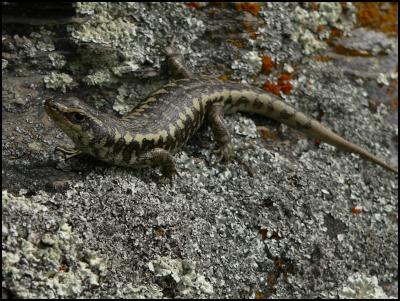Harsh winter a setback for captive skink programme
Harsh winter a setback for captive skink programme

Click to enlarge
Photo: Otago skink (Oligosoma otagense) Photo: Trent Bell
Harsh winter a setback for captive skink programme
Four captive Otago skinks bred in the North Island and relocated to new facilities in Alexandra have succumbed to the unusually severe winter conditions. Although their loss is a blow, vital lessons have been learnt for the future conservation of the species.
Otago skinks are critically endangered, and are predicted to become extinct within 10 years if nothing is done to save them. The Central Otago Ecological Trust, set up in partnership with the Department of Conservation and Landcare Research, plans to build a lizard breeding and information centre, with the ultimate aim of establishing a predator-free 24-hectare skink sanctuary near Alexandra. In November, the Trust took ownership of Otago skinks bred in Wellington and Levin, to find out how they would adapt to Otago conditions.
Skinks kept indoors at the new Alexandra Museum are thriving. Of the five kept outside, just one survived the extreme Central Otago winter, which saw sub-zero temperatures lasting for days on end; the June mean temperature was the coldest for at least 10 years. While every effort was made to provide conditions of the same standard the skinks were used to in the north, clearly the central Otago conditions present new challenges to both the skinks and their keepers.
“In cold weather, skinks go into torpor and hide away, and it’s best not to disturb them,” says Landcare Research ecologist Dr Grant Norbury, a member of the Trust and also one of the keepers. “Unfortunately, when the weather abated, three skinks were discovered dead, and one emerged sick and later died.”
“It is now apparent that the standard cage design used throughout New Zealand is inadequate to maintain skinks in Central Otago winters,” says Landcare Research herpetologist (lizard scientist) Trent Bell, who takes close care of the skinks and is an advisor to the Trust.
DOC’s Programme Manager for Grand and Otago skinks Dr James Reardon says while the loss of the skinks is a blow, it is important not to become despondent.
“This is the first time we have attempted to manage this species in captivity in the harsh Central Otago climate. Knowing the cage design is inadequate is a significant learning experience for us, and will make a huge contribution to successful management of the species in future.”
Dr Norbury says the Trust is taking advice from DOC and other skink breeders about new cage designs to test before next winter. “We need to simulate the thermal properties of the large schist rocks this species hides amongst, before taking responsibility for more animals to re-establish populations in the wild.”
New cages will be placed inside a -8°C freezer with thermal probes placed at various points. If temperatures do not fall below zero over several days, this will indicate that skinks should be able to find refuge from frost in case of another extreme winter.
ENDS


 ChargeNet: EV infrastructure co-funding model welcomed
ChargeNet: EV infrastructure co-funding model welcomed NZ Trucking Association: TruckSafe New Zealand Launches | A Game-Changer For Heavy Vehicle Safety And Compliance
NZ Trucking Association: TruckSafe New Zealand Launches | A Game-Changer For Heavy Vehicle Safety And Compliance Gaurav Mittal, IMI: How Can We Balance AI’s Potential And Ethical Challenges?
Gaurav Mittal, IMI: How Can We Balance AI’s Potential And Ethical Challenges? Science Media Centre: Several US-based Environmental Science Databases To Be Taken Down – Expert Reaction
Science Media Centre: Several US-based Environmental Science Databases To Be Taken Down – Expert Reaction Consumer NZ: Despite Low Confidence In Government Efforts, People Want Urgent Action To Lower Grocery Bills
Consumer NZ: Despite Low Confidence In Government Efforts, People Want Urgent Action To Lower Grocery Bills NZ Banking Association: Banks Step Up Customer Scam Protections And Compensation
NZ Banking Association: Banks Step Up Customer Scam Protections And Compensation